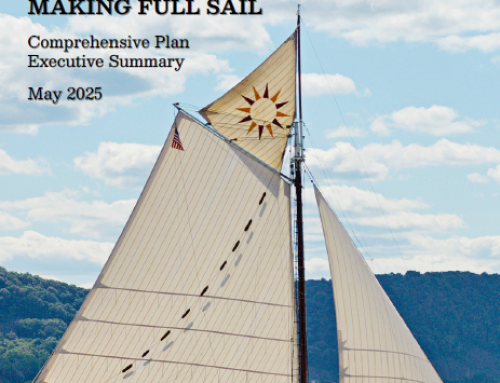Re: Case #15-E-0302 – Proceeding on Motion of the Commission to Implement a Large-Scale Renewable Program and a Clean Energy Standard
Dear Secretary Burgess:
Hudson River Sloop Clearwater, Inc. urges the NY State Public Service Commission to reconsider the recommendations in the Staff’s Responsive Proposal for Preserving Zero-Emissions Attributes in Case 15-E-0302 that call for a mandatory nuclear subsidy, which is estimated to cost New Yorkers more than $7 billion over the course of the next 12 years.
On July 8, 2016, the Department of Public Service Staff (“Staff”) submitted a new proposal in the Proceeding on Motion of the Commission to Implement a Large-Scale Renewable Program and a Clean Energy Standard (“Clean Energy Standard Proceeding”). The new document is entitled “Staff’s Responsive Proposal for Preserving Zero-Emissions Attributes” (“Staff’s New Proposal”). It represents significant changes to Staff’s earlier proposal for a nuclear tier as detailed in Staff’s January 25, 2016 Clean Energy Standard White Paper. The new proposal includes dramatic changes to the policy, including changes to the structure of the proposed nuclear tier, how nuclear subsidies would be calculated, how much they will cost, how costs and benefits are considered, which generators may be eligible, and more. For instance, Staff’s earlier cost estimates for the nuclear tier ranged from $59 million to $658 million over the first 7 years. Now, under the new proposal, Staff estimates the cost at $953 million for only the first two years. The subsidy charged to ratepayers will escalate from $17.48 per MWh in 2017-2019 to $29.15 per MWh in 2027-2029 (depending on energy and capacity price adjustments), locking New York ratepayers into a huge subsidy estimated to be $7.6 billion over the 12 year term of the proposal. In addition, the PSC Staff’s revised recommendation allows for the inclusion Indian Point in the proposed nuclear subsidy, which could add another $3 billion to the cost of its proposal, for a potential total of more than $10 billion, which would be funded by ratepayers, including residents of all income levels, large and small businesses, non-profits, and municipalities. In the Mid-Hudson region, this would compound already high rates and the Lower Hudson Capacity Zone surcharge
The change in cost is a result of a completely new approach for determining the price of so-called “Zero Emissions Credits” (ZECs) which nuclear generators would receive. This change alone will clearly have significant new impacts on ratepayers, utility responsibilities, and electricity markets. Another proposed change is that reactors would now need a “determination of public necessity” and that the Commission would make this determination for some reactors upon inception of the program. If approved, the Commission would lock in subsidies for nuclear reactors in upstate New York for a 12-year period.
The Staff report leaves many unanswered questions regarding the actual cost that will be borne by ratepayers and how this will affect our economy, especially for low and moderate income families, businesses who operate on the margin and municipalities with stretched budgets that are capped.
Nuclear is NOT emission-free! By referring to nuclear power as having “zero-emission attributes”, the Staff’s proposal ignores emissions generated in mining, milling, enriching, transporting and storing nuclear fuel, and the planned and unplanned releases of radioactive isotopes and other emissions associated with nuclear operations. The proposal likewise ignores the creation of high-level radioactive waste in the form spent nuclear fuel rods, which will likely be stored in New York State for many decades. It also exaggerates the reliability of aging nuclear facilities, which have recently experienced increasingly frequent outages due to leaks, fires, electrical problems, and, in the case of Indian Point, severely degraded baffle-former bolts inside the reactor. And it ignores the potential dangers associated with ongoing operations of aging and deteriorating facilities over which the PSC has no jurisdiction and the Nuclear Regulatory Commission has demonstrated insufficient oversight, as demonstrated by their failure to require a comprehensive root-cause analysis before restarting IP Unit-2 and failing to close Unit-3 for inspections, knowing that it is very likely that the baffle-former bolts inside IP-3’s reactor are also degraded.
New York no longer needs nuclear power in its energy portfolio, now or in the future. Ten years ago the transition to a renewable energy economy was still a future possibility. Today it is well underway, with solar already scaling up from kilowatt to megawatt systems, as community and utility-sized projects are being sited, designed and constructed all around the state. There is a huge potential for more land-based wind turbines, as well as offshore wind, which can especially help to power the greater New York City metropolitan area, and is being actively solicited. The NYS Energy Research and Development Authority (NYSERDA) is coordinating with the Board of Offshore Energy Management (BOEM) and sponsoring an environmental assessment of the marine ecology, and mapping commercial fisheries and shipping lanes to pave the way for this technology in the short term. With pending transmission upgraded, improved energy efficiency and demand response, and increased storage capability, the future is here, but this needs to be better documented in a cohesive roadmap and subsidized where needed instead of – not on addition to – nuclear subsidies. The NY State Energy Plan relies far too heavily on natural gas as a “bridge fuel,” ignoring the impact of methane releases which plague this very unnaturally fracked resource. The only bridge to a renewable energy economy is to put renewable energy infrastructure in place as wisely and rapidly as possible.
The Synapse Reports,[1] the NY State Department of State (DOS), the New York Independent System Operator (NYISO) and others have documented energy sufficiency without Indian Point and the upstate reactors. As recently as April 2016, the NYISO reversed its former concern regarding the deactivation of FitzPatrick in a letter in which they “determined that there is no longer an immediate reliability need that must be addressed through the NYISO’s Gap Solution Process,”[2] and then concluded definitively in a presentation that “Revised FitzPatrick Results: No Statewide Resource Need.”[3] As renewable generation ramps up, Ginna and Nine Mile Point can also be phased out.
The NY State Department of State specifically addressed the question of replacement energy for Indian Point when it determined that Entergy’s relicensing application for Units 2 and 3 was not consistent with the Coastal Management Plan for environmental and economic reasons, and that the energy generated by these reactors was unnecessary to maintain reliability.[4] They cited a variety of studies, the Indian Point Reliability Contingency Plan, transmission and infrastructure improvements and increased demand response and energy efficiency to concluded that “…the New York electric power system can be expected to operate reliably without Indian Point Unit 2 and Unit 3 at the time of soon after their licenses expire” [in 2013 and 2015 respectively]. The DOS coastal consistency determination also lists many negative impacts of relicensing these aging and failing reactors for another 20 years of operation on the Hudson River’s ecology and fisheries, seismic dangers, the absence of a plan to safely store or dispose of nuclear waste, ongoing and worsening leaks of radioactive isotopes into the groundwater and the Hudson River, an extensive record of accidents, leaks and other unplanned shutdowns, the lack of a viable evacuation plan, and numerous other reasons to deny a Coastal Consistency determination.
ZECs contradict REV: Forcing New Yorkers pay to bail out aging and unprofitable nuclear reactors is in direct contradiction to many of the goals of the PSC’s proceedings, Reforming the Energy Vision (REV) for New York, which stress shifting to distributed energy resources, ensuring affordability, and allowing the marketplace to work. This may be one of the largest corporate bailouts this state has ever faced, obligating ratepayers to subsidize nuclear power, when renewable energy is abundantly available and urgently needed. That’s where our dollars should be invested. The fact that the ratio of investment of ZECs to RECs is 2:1 adds insult to injury.
ZECs constrain customer choice: Because the Load Serving Entities – the utilities and Energy Service Companies (ESCOs) – would be required to bill their customers for the so-called Zero Emission Credits (ZECs), customers would no longer have the option of choosing to purchase 100% renewable energy, because they would be forced to pay the nuclear surcharge regardless of whether or not they want to purchase nuclear power.
New York should take a lesson from California: The California Public Utility Commission recently created a plan to phase out their last nuclear power plant, by facilitating a joint agreement between Pacific Gas & Electric, the unions representing the plant workers, environmental groups and municipal officials, replacing the power generated by Diablo Canyon with 100% renewable energy over the course of nine years, while protecting the workers’ jobs and providing retraining where needed — without mandating any subsidy that ratepayers would fund.
Unlike California, New York’s energy system is deregulated, so the NYS PSC has no direct jurisdiction over nuclear plants here – and has no clear plan to transition to a renewable energy economy – yet Staff is proposing to impose an estimated $7 to $10 billion subsidy to underwrite the currently unprofitable operations of FitzPatrick, Ginna, and Nine Mile Point nuclear power stations – and likely Indian Point as well, if other proceedings don’t force its closure.
We urge the Public Service Commission to deny the Staff’s Responsive Proposal for Preserving Zero-Emissions Attributes in its current form and to direct Staff to develop a better plan with adequate input from a wide range of stakeholders. Because the Staff’s recommendations will have significant economic impacts on the future of New York ratepayers, Clearwater also requests that, at minimum, the PSC extend the deadline for filing comments on the Staff’s proposal to the full 45-days, as is customary under State Administrative Procedures Act (SAPA), to allow adequate time to review the substantial changes contained in this proposal and to benefit from alternative suggestions that may result.
One of the greatest challenges of this decade is to transition to a renewable energy economy without burning more fossil fuel. These subsidies would be much better invested in the rapid deployment of large-scale solar, on-land and offshore wind, hydroelectric, storage and efficiency, than in bailing out aging and unprofitable nuclear facilities without the public even understanding what is being proposed or how it will impact them.
Thank you very much for your consideration of this important request and related comments.
Sincerely,
Manna Jo Greene, Environmental Director
Hudson River Sloop Clearwater, Inc.
845-265-8080 x 7113 845-807-1270 (cell)
mannajo@clearwater.org
[1] Synapse Energy Economics for NRDC, www.synapse-energy.com/
[2] Chao, H. , NYISO, April 22, 2016 www.nyiso.com/public/webdocs/
[3] Smith, Z. and Walters, D., NYISO, Updated FitzPatrick Deactivation Assumptions, slide 8; an April 26, 2016 www.nyiso.com/public/webdocs/
[4] NYS Dept. of State Coastal Zone Management Act Consistency Determination, letter from Cesar Perales to Fred Dacimo of Entergy, Nov. 6, 2015; p. 27. http://rogerwitherspoon.com/





